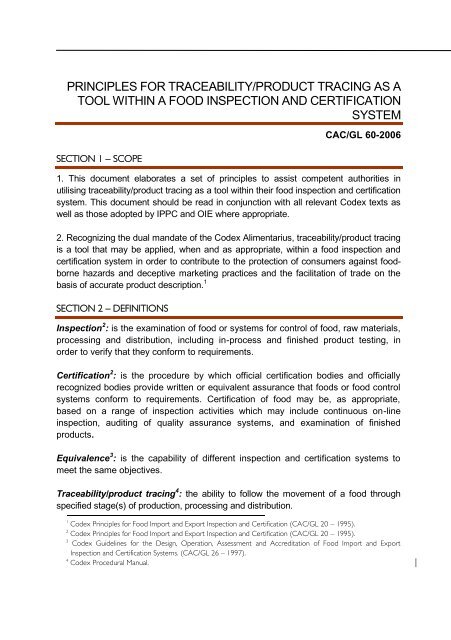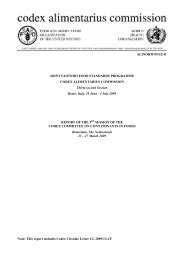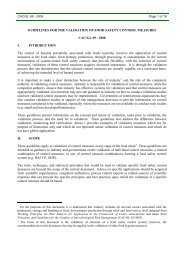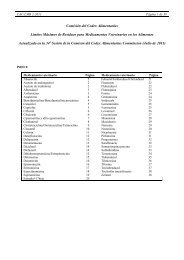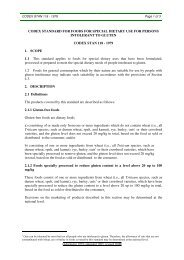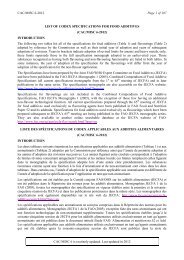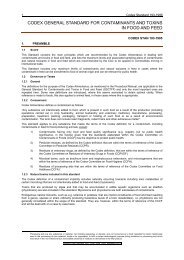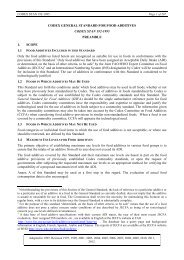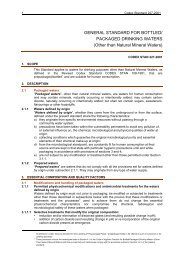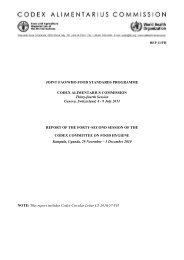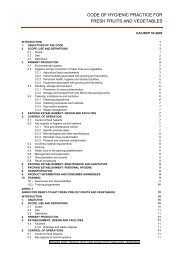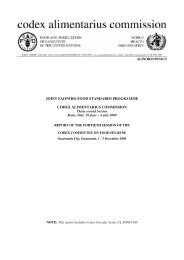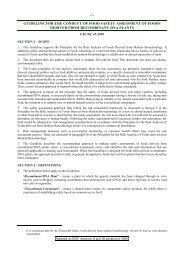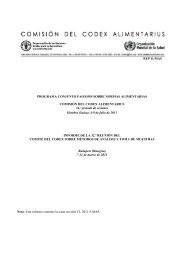Principles for Traceability / Product Tracing as a Tool Within a Food
Principles for Traceability / Product Tracing as a Tool Within a Food
Principles for Traceability / Product Tracing as a Tool Within a Food
You also want an ePaper? Increase the reach of your titles
YUMPU automatically turns print PDFs into web optimized ePapers that Google loves.
PRINCIPLES FOR TRACEABILITY/PRODUCT TRACING AS A<br />
TOOL WITHIN A FOOD INSPECTION AND CERTIFICATION<br />
SYSTEM<br />
SECTION 1 – SCOPE<br />
CAC/GL 60-2006<br />
1. This document elaborates a set of principles to <strong>as</strong>sist competent authorities in<br />
utilising traceability/product tracing <strong>as</strong> a tool within their food inspection and certification<br />
system. This document should be read in conjunction with all relevant Codex texts <strong>as</strong><br />
well <strong>as</strong> those adopted by IPPC and OIE where appropriate.<br />
2. Recognizing the dual mandate of the Codex Alimentarius, traceability/product tracing<br />
is a tool that may be applied, when and <strong>as</strong> appropriate, within a food inspection and<br />
certification system in order to contribute to the protection of consumers against foodborne<br />
hazards and deceptive marketing practices and the facilitation of trade on the<br />
b<strong>as</strong>is of accurate product description. 1<br />
SECTION 2 – DEFINITIONS<br />
Inspection 2 : is the examination of food or systems <strong>for</strong> control of food, raw materials,<br />
processing and distribution, including in-process and finished product testing, in<br />
order to verify that they con<strong>for</strong>m to requirements.<br />
Certification 2 : is the procedure by which official certification bodies and officially<br />
recognized bodies provide written or equivalent <strong>as</strong>surance that foods or food control<br />
systems con<strong>for</strong>m to requirements. Certification of food may be, <strong>as</strong> appropriate,<br />
b<strong>as</strong>ed on a range of inspection activities which may include continuous on-line<br />
inspection, auditing of quality <strong>as</strong>surance systems, and examination of finished<br />
products.<br />
Equivalence 3 : is the capability of different inspection and certification systems to<br />
meet the same objectives.<br />
<strong>Traceability</strong>/product tracing 4 : the ability to follow the movement of a food through<br />
specified stage(s) of production, processing and distribution.<br />
1 Codex <strong>Principles</strong> <strong>for</strong> <strong>Food</strong> Import and Export Inspection and Certification (CAC/GL 20 – 1995).<br />
2 Codex <strong>Principles</strong> <strong>for</strong> <strong>Food</strong> Import and Export Inspection and Certification (CAC/GL 20 – 1995).<br />
3 Codex Guidelines <strong>for</strong> the Design, Operation, Assessment and Accreditation of <strong>Food</strong> Import and Export<br />
Inspection and Certification Systems. (CAC/GL 26 – 1997).<br />
4 Codex Procedural Manual.<br />
1
2<br />
FOOD IMPORT AND EXPORT INSPECTION AND CERTIFICATION SYSTEMS (5th Edition)<br />
SECTION 3 – PRINCIPLES<br />
3. These principles cover the context, rationale, design and application of<br />
traceability/product tracing <strong>as</strong> a tool <strong>for</strong> use by a competent authority within a food<br />
inspection and certification system.<br />
Context<br />
4. <strong>Traceability</strong>/product tracing, <strong>as</strong> defined above, is one of a number of tools that may<br />
be utilised by a competent authority within its food inspection and certification system.<br />
5. An importing country should consider that a food inspection and certification system<br />
without a traceability/product tracing tool may meet the same objective and produce the<br />
same outcomes (e.g. regarding food safety, provide the same level of protection) <strong>as</strong> a<br />
food inspection and certification system with traceability/product tracing 5 .<br />
6. It should not be mandatory <strong>for</strong> an exporting country to replicate (i.e. establish the<br />
same) the traceability/product tracing tool <strong>as</strong> used by the importing country, when<br />
applicable.<br />
Rationale<br />
7. The application of a traceability/product tracing tool by a competent authority should<br />
improve the effectiveness and/or efficiency of the actions that may be necessary<br />
regarding its me<strong>as</strong>ures or requirements within its food inspection and certification<br />
system.<br />
8. <strong>Traceability</strong>/product tracing is a tool that when applied in a food safety context does<br />
not in itself improve food safety outcomes unless it is combined with appropriate<br />
me<strong>as</strong>ures and requirements. It can contribute to the effectiveness and/or efficiency of<br />
<strong>as</strong>sociated food safety me<strong>as</strong>ures 6 .<br />
9. <strong>Traceability</strong>/product tracing is a tool that when applied in a food inspection and<br />
certification system can contribute to the protection of consumers against deceptive<br />
marketing practices and facilitation of trade on the b<strong>as</strong>is of accurate product<br />
description 7 .<br />
5<br />
Codex Guidelines <strong>for</strong> the Development of Equivalence Agreements Regarding <strong>Food</strong> Import and Export<br />
Inspection and Certification Systems (CAC/GL 34-1999); Codex Guidelines on the Judgement of Equivalence<br />
of Sanitary Me<strong>as</strong>ures Associated with <strong>Food</strong> Inspection and Certification Systems (CAC/GL 53-2003).<br />
6<br />
For example, by providing in<strong>for</strong>mation on suppliers or customers involved in potential food safety issues so<br />
enabling targeted product recall/withdrawal.<br />
7<br />
For example, by rein<strong>for</strong>cing confidence in the authenticity of the product and the accuracy of in<strong>for</strong>mation<br />
provided on the products (e.g. country of origin, organic farming, religious concerns such <strong>as</strong> kosher or halal).
PRINCIPLES FOR TRACEABILITY/PRODUCT TRACING AS A TOOL WITHIN<br />
A FOOD INSPECTION AND CERTIFICATION SYSTEM (CAC/GL 60-2006)<br />
10. In every c<strong>as</strong>e a traceability/product tracing tool should be justified within the context<br />
of the food inspection and certification system and the purpose, objectives and<br />
specifications of the traceability/product tracing tool clearly described. The scope and<br />
extent of application of the tool should also be consistent with the described need.<br />
Design<br />
11. The traceability/product tracing tool may apply to all or specified stages of the food<br />
chain (from production 8 to distribution), <strong>as</strong> appropriate to the objectives of the food<br />
inspection and certification system.<br />
12. The traceability/product tracing tool should be able to identify at any specified stage<br />
of the food chain (from production to distribution) from where the food came (one step<br />
back) and to where the food went (one step <strong>for</strong>ward), <strong>as</strong> appropriate to the objectives<br />
of the food inspection and certification system.<br />
13. The objectives, scope and related procedures of a food inspection and certification<br />
system that includes a traceability/product tracing tool should be transparent and made<br />
available to competent authorities of the exporting country upon request.<br />
Application<br />
14. The application of traceability/product tracing should take into account the<br />
capabilities of developing countries.<br />
15. If in the context of a traceability/product tracing tool an importing country h<strong>as</strong><br />
objectives or outcomes of their food inspection and certification system which cannot<br />
be met by an exporting country, the importing country should consider the provision of<br />
<strong>as</strong>sistance to the exporting country, and especially in the c<strong>as</strong>e of a developing country.<br />
Assistance may include longer time frames <strong>for</strong> implementation, flexibility of design and<br />
technical <strong>as</strong>sistance, so that the objectives or outcomes of the food inspection and<br />
certification system of the importing country can be met.<br />
16. A food inspection and certification system within which a traceability/product tracing<br />
tool is applied should not be more trade restrictive than necessary.<br />
17. The application of the traceability/product tracing tool should be practical,<br />
technically fe<strong>as</strong>ible and economically viable within a food inspection and certification<br />
system.<br />
8 <strong>Product</strong>ion could be interpreted in such a broad manner <strong>as</strong> to cover food producing animals, feed, fertilizers,<br />
pesticides, veterinary drugs and any input of plant or animal origin, etc. if relevant <strong>for</strong> specific applications of<br />
traceability/product tracing to food.<br />
3
4<br />
FOOD IMPORT AND EXPORT INSPECTION AND CERTIFICATION SYSTEMS (5th Edition)<br />
18. In deciding whether and how to apply the traceability/product tracing tool, in the<br />
context of a food inspection and certification system the competent authority should<br />
take account of the <strong>as</strong>sessed food safety risks and/or the characteristics of the potential<br />
deceptive marketing practices being addressed.<br />
19. <strong>Traceability</strong>/product tracing tool within the context of a food inspection and<br />
certification system should be implemented when and <strong>as</strong> appropriate on a c<strong>as</strong>e by<br />
c<strong>as</strong>e b<strong>as</strong>is.


